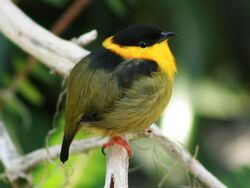Biology:Golden-collared manakin
| Golden-collared manakin | |
|---|---|

| |
| Scientific classification | |
| Domain: | Eukaryota |
| Kingdom: | Animalia |
| Phylum: | Chordata |
| Class: | Aves |
| Order: | Passeriformes |
| Family: | Pipridae |
| Genus: | Manacus |
| Species: | M. vitellinus
|
| Binomial name | |
| Manacus vitellinus (Gould, 1843)
| |

| |
The golden-collared manakin (Manacus vitellinus) is a species of bird in the family Pipridae.
It is found in Colombia and Panama. Its natural habitats are subtropical or tropical moist lowland forest and heavily degraded former forest.
Reproduction
Male golden-collared manakins perform an acrobatic display and use vocalizations to court females.[2] Males emit a specific chee-poo sound during courtship. Studies have examined whether the call of golden-collared manakins is physiologically controlled by peripheral androgen receptors. When androgen receptors outside of the central nervous system were inhibited, this resulted in an increase in the duration of the chee note and a decrease in the frequency of the poo note.[3] These results show that the activation of peripheral androgen receptors is important for creating a normal sexual call in the golden-collared manakin.[3]
References
- ↑ BirdLife International (2016). "Manacus vitellinus". IUCN Red List of Threatened Species 2016: e.T22701109A93813666. doi:10.2305/IUCN.UK.2016-3.RLTS.T22701109A93813666.en. https://www.iucnredlist.org/species/22701109/93813666. Retrieved 12 November 2021.
- ↑ Fuxjager, Matthew J.; Heston, Jonathan B.; Schlinger, Barney A. (July 2014). "Peripheral androgen action helps modulate vocal production in a suboscine passerine". The Auk 131 (3): 327–334. doi:10.1642/auk-13-252.1. ISSN 0004-8038. PMID 25780269.
- ↑ Jump up to: 3.0 3.1 Fuxjager, Matthew J.; Longpre, Kristy M.; Chew, Jennifer G.; Fusani, Leonida; Schlinger, Barney A. (2013-06-19). "Peripheral Androgen Receptors Sustain the Acrobatics and Fine Motor Skill of Elaborate Male Courtship". Endocrinology 154 (9): 3168–3177. doi:10.1210/en.2013-1302. ISSN 0013-7227. PMID 23782945.
Wikidata ☰ Q776043 entry
 |


